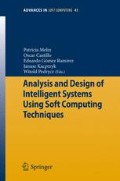Abstract
This paper presents a new way to solve the inverse problem of electrocardiography in terms of heart model parameters. The developed event estimation and recognition method uses a unified neural network (UNN)-based optimization system to determine the most relevant heart model parameters. A UNN-based preliminary ECG analyzer system has been created to reduce the searching space of the optimization algorithm. The optimal model parameters were determined by a relation between objective function minimization and robustness of the solution. The final evaluation results, validated by physicians, were about 96% correct. Starting from the fact that input ECGs contained various malfunction cases, such as Wolff-Parkinson-White (WPW) syndrome, atrial and ventricular fibrillation, these results suggest this approach provides a robust inverse solution, circumventing most of the difficulties of the ECG inverse problem.
Access this chapter
Tax calculation will be finalised at checkout
Purchases are for personal use only
Preview
Unable to display preview. Download preview PDF.
References
Thaker, N.V., Ferrero, J.M.: Electrophysiologic models of heart cells and cell networks. IEEE Eng. Med. Biol. Soc. Magazine 17(5), 73–83 (1998)
MacLeod, R.S., Brooks, D.H.: Recent progress in inverse problems in electrocardiology. IEEE Eng. Med. Biol. Soc. Magazine 17(1), 73–83 (1998)
Szilágyi, S.M.: Event Recognition, Separation and Classification from ECG Recordings. In: Proc 20th Ann. Int. Conf. IEEE EMBS, pp. 236–239. IEEE Computer Society Press, Los Alamitos (1998)
Cuppen, J.J.M., van Oosterom, A.: Model studies with inversely calculated isochrones of ventricular depolarization. IEEE Trans. Biomed. Eng. 31, 652–659 (1984)
Guanglin, L., Bin, H.: Localization of the site of origin of cardiac activation by means of a heart-model-based electrocardiographic imaging approach. IEEE Trans. Biomed. Eng. 48, 660–669 (2001)
Shahidi, A.V., Savard, P., Nadeau, R.: Forward and inverse problems of electrocardiography: modeling and recovery of epicardial potentials in humans. IEEE Trans. Biomed. Eng. 41, 249–256 (1994)
Mirvis, D.M.: Validation of body surface electrocardiographic mapping. In: Mirvis, D.M. (ed.) Body surface electrocardiographic mapping, pp. 63–74. Kluwer, Dordrecht (1988)
Minami, K., Nakajima, H., Yoyoshima, T.: Real time discrimination of the ventricular tachyarrhythmia with Fourier-transform neural network. IEEE Trans. Biomed. Eng. 46, 179–185 (1999)
Lagerholm, M., et al.: Clustering ECG complexes using Hermite functions and self-organizing maps. IEEE Trans. Biomed. Eng. 47, 838–847 (2000)
Osowski, S., Hoai, L.T.: ECG beat recognition using fuzzy hybrid neural network. IEEE Trans. Biomed. Eng. 48, 1265–1271 (2001)
Osowski, S., Hoai, L.T., Markiewicz, T.: Support vector machine-based expert system for reliable heartbeat recognition. IEEE Trans. Biomed. Eng. 51, 582–589 (2004)
Vapnik, V.: Statistical learning theory. Wiley, New York (1998)
Smola, A., Scholkopf, B.: A tutorial on support vector regression. Royal Holloway College, Univ. London, NeuroColt Tech. Rep., NV2-TR-1998-030 (1998)
Szilágyi, S.M., Benyó, Z., Dávid, L.: Heart model based ECG signal processing. In: Proc. 5th IFAC Symp. Modell Contr. Biomed. Syst., pp. 213–217 (2003)
Szilágyi, S.M., Benyó, Z., Dávid, L.: WPW syndrome identification and classification using ECG analysis. In: Proc. World Congr. Med. Phys. Biomed. Eng. (2003)
Author information
Authors and Affiliations
Editor information
Rights and permissions
Copyright information
© 2007 Springer-Verlag Berlin Heidelberg
About this chapter
Cite this chapter
Szilágyi, S.M., Szilágyi, L., Benyó, Z. (2007). Spatial Heart Simulation and Analysis Using Unified Neural Network. In: Melin, P., Castillo, O., Ramírez, E.G., Kacprzyk, J., Pedrycz, W. (eds) Analysis and Design of Intelligent Systems using Soft Computing Techniques. Advances in Soft Computing, vol 41. Springer, Berlin, Heidelberg. https://doi.org/10.1007/978-3-540-72432-2_35
Download citation
DOI: https://doi.org/10.1007/978-3-540-72432-2_35
Publisher Name: Springer, Berlin, Heidelberg
Print ISBN: 978-3-540-72431-5
Online ISBN: 978-3-540-72432-2
eBook Packages: EngineeringEngineering (R0)

